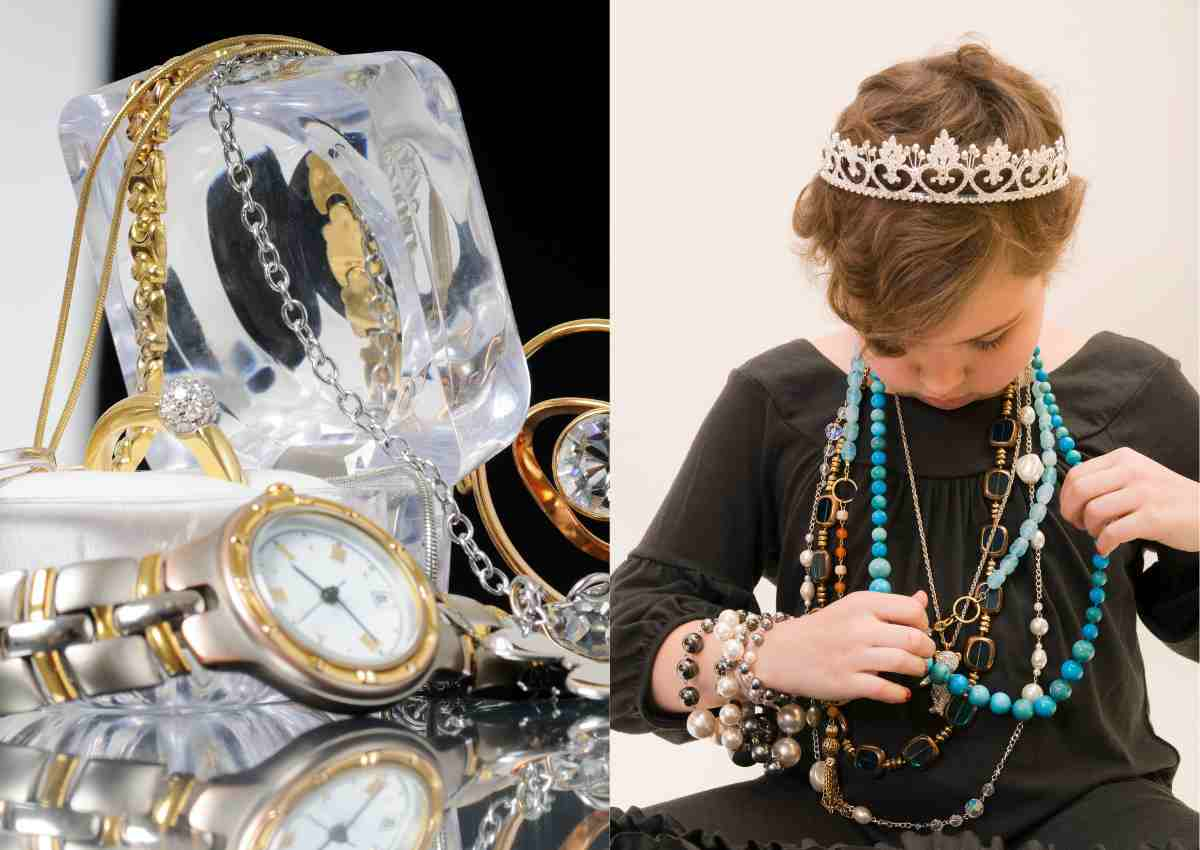Fashion is a dynamic and ever-evolving industry, with jewelry playing a significant role in personal style and self-expression. To navigate the world of jewelry effectively, it’s essential to distinguish between two prominent categories: fashion jewelry and costume jewelry. Understanding the difference between these two types of adornments can help consumers make informed choices, whether shopping for themselves or seeking gifts for others.
Fashion jewelry, or fine jewelry, encompasses pieces crafted from high-quality materials like precious metals (such as gold, silver, or platinum) and genuine gemstones (like diamonds, rubies, or sapphires). These materials are valued for their rarity, durability, and intrinsic worth. Fashion jewelry is often associated with luxury and is designed to stand the test of time, becoming heirlooms or long-lasting accessories.
On the other hand, costume jewelry, also known as fashion or imitation jewelry, is typically made from non-precious metals like brass, copper, or alloy and may feature imitation gemstones or synthetic crystals. The emphasis in costume jewelry is more on fashion-forward design and affordability than on the intrinsic value of the materials used. It often replicates the look of fine jewelry but without the associated high cost.

Importance of Understanding the Difference
- Economic Considerations: Recognizing the distinction between fashion and costume jewelry is crucial for budget-conscious shoppers. It allows individuals to make informed decisions based on their financial capacity, ensuring they acquire jewelry that aligns with their budgetary constraints.
- Style and Fashion Choices: Understanding differences is essential for making style and fashion choices. Whether aiming for a timeless, elegant look (where fashion jewelry may be preferred) or experimenting with trendy, statement pieces (where costume jewelry shines), your choice depends on your personal style goals.
- Gift Selection: When selecting jewelry as a gift for a loved one, knowing the difference between these two categories helps choose a meaningful and appropriate piece that suits the recipient’s taste and lifestyle.
- Collectibility and Investment: For those interested in jewelry as a hobby or investment, recognizing the distinction between the two types is fundamental. Fashion jewelry, with its use of precious materials, can be appreciated over time, while costume jewelry is often collected for its aesthetic appeal and historical significance.
In the subsequent sections, we will delve deeper into the characteristics that differentiate fashion jewelry from costume jewelry, providing a comprehensive understanding of each category.
More Post: What are some fun Halloween costume ideas for groups?
Characteristics of Costume Jewelry
Costume jewelry, also known as fashion or imitation jewelry, possesses distinct characteristics that set it apart from fashion jewelry.
Materials Used
- Non-Precious Metals: Costume jewelry is typically crafted from base metals like brass, copper, or alloy. These materials are more readily available and cost-effective compared to precious metals. While they lack the intrinsic value of gold or silver, they can be plated or coated to mimic the appearance of these higher-end materials.
- Imitation Gemstones: In costume jewelry, gemstones are often simulated or synthetic, designed to replicate the look of genuine gems without the associated cost. Materials like cubic zirconia, glass crystals, or even plastic are common substitutes for precious and semi-precious gemstones.
Craftsmanship
- Mass-Produced: Costume jewelry is typically mass-produced using industrial methods. This allows for producing large quantities of identical or similar pieces at a lower cost. Mass production often results in less individualized attention to each item.
- Less Attention to Detail: Due to the emphasis on affordability, costume jewelry may exhibit less intricate craftsmanship and attention to detail when compared to fashion jewelry. While designs can still be aesthetically pleasing, they may lack the precision and meticulousness found in fine jewelry.
Design
- Often Vintage or Retro-Inspired: Costume jewelry frequently draws inspiration from vintage or retro styles. These pieces aim to capture the elegance and glamour of bygone eras, making them popular choices for themed events or nostalgic fashion enthusiasts.
- Less Influenced by Current Trends: Unlike fashion jewelry, which closely follows current fashion trends, costume jewelry tends to maintain a timeless quality. This makes it suitable for various occasions and outfits without becoming outdated quickly.
Price
- Affordable and Budget-Friendly: One of the primary appeals of costume jewelry is its affordability. It allows consumers to enjoy stylish and eye-catching accessories without a significant financial commitment.
- Fashion-Forward Without Breaking the Bank: Costume jewelry offers a way to stay on-trend without investing in expensive pieces. This affordability encourages experimentation with various styles and allows for more frequent wardrobe updates.
Historical Perspective
- Origins of Fashion Jewelry: Fashion jewelry, also called fine jewelry, has its roots in ancient civilizations. It has evolved over the centuries, with craftsmanship and using precious materials at its core.
- Origins of Costume Jewelry: Costume jewelry originated in the 18th century when it was initially created as theatrical props to resemble real jewelry without expense. It gained popularity during the Art Deco era and flourished in the mid-20th century.
- Evolution of Both Over Time: Both fashion and costume jewelry have evolved significantly. Fashion jewelry has embraced innovative designs and materials, while costume jewelry has continued to provide accessible, stylish alternatives.
Popularity and Usage
Occasions for Wearing Fashion Jewelry: Fashion jewelry is often reserved for special occasions such as weddings, formal events, or heirloom pieces passed down through generations. These pieces are considered investments and are cherished for their sentimental and monetary value.
Occasions for Wearing Costume Jewelry: Costume jewelry is versatile and can be worn daily or casually. It’s a popular choice for adding flair to everyday outfits, completing themed looks, or expressing personal style.
How Preferences Have Changed Over the Years: In recent years, there has been a growing trend towards sustainability and ethical consumption, influencing preferences for both fashion and costume jewelry. Consumers now value the story behind the piece and its environmental impact, leading to an increased interest in vintage and artisanal jewelry in both categories.
Quality and Durability
Understanding the longevity and durability of jewelry is crucial when considering whether to invest in fashion or costume pieces.
Longevity of Fashion Jewelry
Fashion jewelry, made from precious metals and genuine gemstones, is designed to withstand the test of time. With proper care, these pieces can last for generations and even become heirlooms. The durability of fashion jewelry is attributed to the strength of materials like gold and silver and the hardness and resistance to scratching of real gemstones.
Longevity of Costume Jewelry
Costume jewelry, made from base metals and imitation gemstones, generally has a shorter lifespan than fashion jewelry. While they can endure regular wear and occasional use, they may show signs of wear and tear more quickly. Costume jewelry may tarnish or lose its shine over time, and imitation gemstones can become scratched or discolored.
More Post: What is a good costume for a crossdresser in a Halloween contest?
Factors Affecting Durability
Several factors can influence the longevity of both fashion and costume jewelry:
- Maintenance: Regular cleaning and proper storage can extend the life of both types of jewelry.
- Frequency of Wear: Items worn daily may show signs of wear more quickly than occasionally.
- Exposure to Elements: Contact with chemicals, moisture, and sunlight can affect the condition of jewelry, especially costume pieces.
- Quality of Craftsmanship: Even within the costume jewelry category, there can be variations in craftsmanship. Pieces that are better made tend to last longer.
- Plating or Coating: The quality of plating or coating on costume jewelry can impact how well it retains its appearance. Higher-quality coatings may resist tarnishing and fading longer.
Collectibility and Value
Both fashion and costume jewelry can hold value and be collected for various reasons.
Collecting Fashion Jewelry
- Brands and Designers: Many fashion jewelry brands and designers have a dedicated following of collectors. Pieces from renowned designers often appreciate value over time, making them sought-after investments.
- Limited Editions: Limited-edition fashion jewelry items, especially those associated with famous designers or worn by celebrities, can become highly collectible and valuable.
Collecting Costume Jewelry
- Vintage Pieces: Vintage costume jewelry, particularly from the mid-20th century, has gained popularity among collectors. These pieces capture the style of past eras and can be valuable due to their historical significance.
- Historical Significance: Some costume jewelry pieces are historically significant, reflecting the cultural and fashion trends of their time. Collectors often seek these items for their historical value and unique designs.
Conclusion
In conclusion, the distinction between fashion jewelry and costume jewelry lies in their materials, craftsmanship, design, and pricing. Fashion jewelry is crafted from precious materials and gemstones, characterized by fine craftsmanship, trendy designs, and a higher price point. In contrast, costume jewelry uses non-precious materials and imitation gemstones, often features vintage-inspired designs, and is more budget-friendly.
Understanding these differences is essential for making informed choices when shopping for jewelry. Personal preferences, budget considerations, and the intended occasions for wearing the jewelry all play a significant role in determining which type is the right fit.
Both fashion and costume jewelry have their places in the world of fashion and self-expression. Fashion jewelry serves as a symbol of luxury and elegance, while costume jewelry allows for creativity and experimentation without breaking the bank. Ultimately, the choice between the two depends on individual tastes, needs, and the desired style statement.



